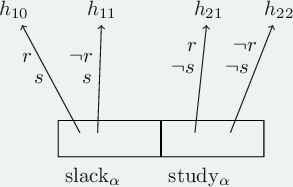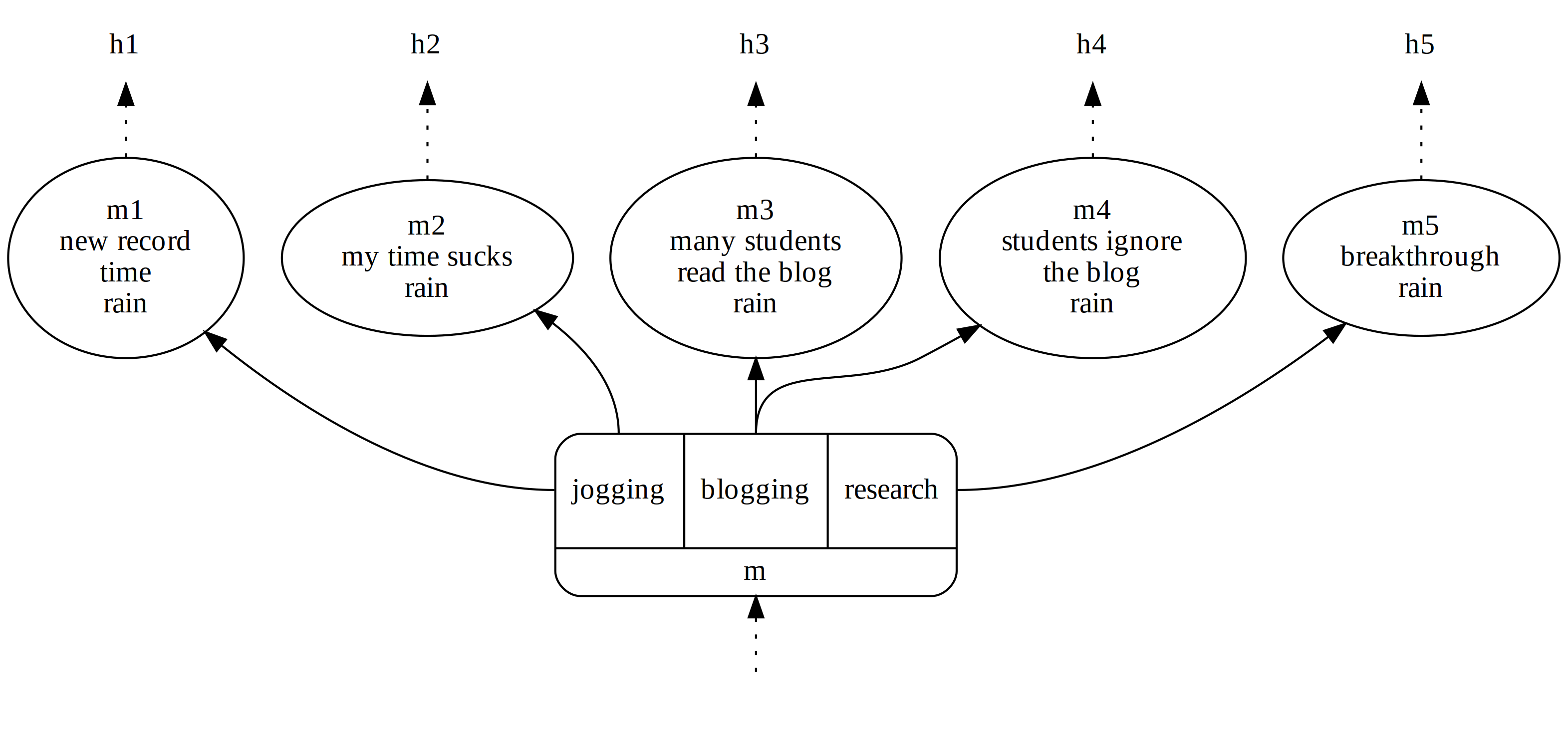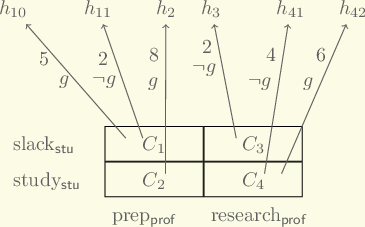Last time we have learned about the \(\mathsf{cstit}\) operator for individual agents. Today we look at a variant which infuses a deliberative flavor into the operator, the so-called \(\mathsf{dstit}\). We will also develop a better understanding of the notion of refraining. Finally we will consider group actions.1
Deliberative stit
For instance, one may demand that if an agent sees to it that \(A\) then there should have been at least the possibility that \(\neg A\) turns out to be true. Otherwise, so one may argue, our agent doesn’t really have a choice in the matter and she didn’t really see to it that \(A\) but the circumstances already necessitated that \(A\). For instance,
In our scenarios we have \(m/h_i \models [\alpha ~\mathsf{cstit{:}}~ \mathtt{rain}]\). However, at the same time we have \(m/h_i \models \Box \mathtt{rain}\).
In order to avoid such scenarios, another variant of a \(\mathsf{stit}\) operator has been introduced: \(\mathsf{dstit}\), the deliberative stit. It can be defined as follows:
- \(m/h \models [\alpha ~\mathsf{dstit{:}}~ A]\) iff \(m/h \models [\alpha ~\mathsf{cstit{:}}~ A] \wedge \Diamond \neg A\).
If it is possible that \(A\) turns out to be false, our agent has the ability to deliberate on whether she brings about \(A\) or not. If she goes for it, she deliberately sees to it that \(A\).
Exercise: An alternative way to define a deliberative stit-operator is by
- \(m/h \models [\alpha ~\mathsf{dstit{:}}~ A]\) iff \(m/h \models [\alpha ~\mathsf{cstit{:}}~ A] \wedge \Diamond \neg [\alpha ~\mathsf{cstit{:}}~ A]\).
How are the two definitions related? Does one imply the other one, are they equivalent, etc.?
Solution. (Click me!)
Note that there are many differences in the logical behavior of \(\mathsf{cstit}\) and \(\mathsf{dstit}\). For instance, for tautological formulas \(A\), \([\alpha ~\mathsf{dstit{:}}~ A]\) is always (at any moment-history pair) false, while \([\alpha ~\mathsf{cstit{:}}~ A]\) is always true.
Exercise: Does the following hold at any moment-history pair \(m/h\) in any stit-model \(M\):
- \(M, m/h \models [\alpha ~\mathsf{dstit{:}}~ A \wedge B] \leftrightarrow \left( [\alpha ~\mathsf{dstit{:}}~ A] \wedge [\alpha ~\mathsf{dstit{:}}~ B] \right)\)?
- \(M, m/h \models [\alpha ~\mathsf{dstit{:}}~ A \wedge B] \leftrightarrow \left( [\alpha ~\mathsf{cstit{:}}~ A] \wedge \Diamond \neg A \wedge [\alpha ~\mathsf{cstit{:}}~ B] \wedge \Diamond \neg B \right)\)?
- \(M, m/h \models [\alpha ~\mathsf{dstit{:}}~ A \wedge B] \leftrightarrow \left( [\alpha ~\mathsf{cstit{:}}~ A] \wedge [\alpha ~\mathsf{cstit{:}}~ B] \wedge \Diamond \neg (A \wedge B) \right)\)?
- \(M,m/h \models [\alpha ~\mathsf{dstit{:}}~ A] \leftrightarrow [\alpha ~\mathsf{dstit{:}}~ [\alpha ~\mathsf{dstit{:}}~ A]]\)?
- \(M, m/h \models \neg [\alpha ~\mathsf{dstit{:}}~ A] \leftrightarrow [\alpha ~\mathsf{dstit{:}}~ \neg [\alpha ~\mathsf{dstit{:}}~ A]]\)?
Contrast your insights with the logical behavior of \(\mathsf{cstit}\).
Solutions (Click me!)
Refraining
How to express that an agent is refraining from seeing to it that \(A\)? A very naive approach would be to use \(\neg [\alpha ~\mathsf{cstit{:}}~ A]\) or \(\neg [\alpha ~\mathsf{dstit{:}}~ A]\). However, very simply scenarios illustrate that this idea does not lead to the desired results. Consider the following, where \(s\) stands for the “slacking” of our agent, and \(r\) for it raining.
 Whether our agent slacks or study, she will always not see to it that it rains (or not rains). However, it seems hardly intuitive to state that she refrains from seeing to it that it rains, after all she couldn’t even do so if she wanted.
Whether our agent slacks or study, she will always not see to it that it rains (or not rains). However, it seems hardly intuitive to state that she refrains from seeing to it that it rains, after all she couldn’t even do so if she wanted.
Nevertheless, refraining clearly has something to do with “not seeing to it that”. The key question is what to add to our naive proposal. We present now two ways to enhance it.
According to the first approach an agent refrains from seeing to it that \(A\) if she does not see to it that \(A\) but it is possible for her to do so. Formally: \[ \neg [\alpha ~\mathsf{dstit{:}}~ A] \wedge \Diamond [\alpha ~\mathsf{dstit{:}}~ A]\]
Consider the following example, where \(p\) may stand for “Passing the exam”:

Our agent refrains from passing that exam at \(h_{10}\) (or \(h_{11}\)) since
- \(m/h_{10} \models \neg [\alpha ~\mathsf{dstit{:}}~ p]\) and
- \(m/h_{10} \models \Diamond [\alpha ~\mathsf{dstit{:}}~ p]\).
Note that our first approach does not explicitly require active choices: the two requirements are (a) that the agent does not choose to see to it that \(A\) and (b) that it is possible to do so. Instead we could approach the notion of refraining in a more active manner by defining refraining to seeing to it that \(A\) as seeing to it to not see to it that \(A\). Formally: \[ [\alpha ~\mathsf{dstit{:}}~ \neg [\alpha ~\mathsf{dstit{:}}~ A]]\]
Coming back to our example, we again have that if our agent slacks then she refrains from passing the exam, since:
- \(m/h_{10} \models [\alpha ~\mathsf{dstit{:}}~ \neg [\alpha ~\mathsf{dstit{:}}~ p]]\)
It is important to note that \(\neg [\alpha ~\mathsf{dstit{:}}~ A]\) does not imply \([\alpha ~\mathsf{dstit{:}}~ \neg [\alpha ~\mathsf{dstit{:}}~ A]]\), as can be seen in our example with the rain above:
- \(m/h_{10} \models \neg [\alpha ~\mathsf{dstit{:}}~ r]\) while
- we don’t have \(m/h_{10} \models [\alpha ~\mathsf{dstit{:}}~ \neg [\alpha ~\mathsf{dstit{:}}~ r]]\) since it is not possible for her to deliberately see to it that it rains.
The situation is different with \(\mathsf{cstit}\) where \(\neg [\alpha ~\mathsf{cstit{:}}~ A]\) implies \([\alpha ~\mathsf{cstit{:}}~ \neg [\alpha ~\mathsf{cstit{:}}~ A]]\). This shows that \(\mathsf{cstit}\) is not a candidate for the second notion of refraining.
As different as the two notions of refraining seem, one can show that their formalizations with \(\mathsf{dstit}\) are equivalent. That is, the following is a theorem in our stit framework:: \[ \left( \neg [\alpha ~\mathsf{dstit{:}}~ A] \wedge \Diamond [\alpha ~\mathsf{dstit{:}}~ A]\right) \leftrightarrow [\alpha ~\mathsf{dstit{:}}~ \neg [\alpha ~\mathsf{dstit{:}}~ A]] \]
Exercise: An interesting question is whether the first notion of refraining can be expressed via \(\mathsf{cstit}\) as well. Check whether \[ \left( \neg [\alpha ~\mathsf{dstit{:}}~ A] \wedge \Diamond [\alpha ~\mathsf{dstit{:}}~ A] \right) \leftrightarrow \left( \neg [\alpha ~\mathsf{cstit{:}}~ A] \wedge \Diamond [\alpha ~\mathsf{cstit{:}}~ A] \right) \] is a theorem.
We consider both cases separately.
Solution (Click me!)
Excercise: An Aristotelian principle says that the ability to act is equivalent to the ability to refrain. Formally: \[ \Diamond [\alpha ~\mathsf{dstit{:}}~ A] \leftrightarrow \Diamond[ \alpha ~\mathsf{dstit{:}}~ \neg [\alpha ~\mathsf{dstit{:}}~ A]] \] Check whether it holds.
We consider both cases separately.
Solution (Click me!)
Group actions
Suppose we have two agents, a student \(\mathsf{stu}\) and a professor \(\mathsf{prof}\). Each has two choices:
- the student can either slack or study,
- the professor can either prepare the course or do research.
Then the situation may look as follows, where \(g\) stands for “A great seminar takes place.”:
Note that neither of our two agents has (individually) the ability to see to it that \(g\). E.g., if the professor prepares the course, there is still the possible outcome \(h_{11}\) in which \(\neg g\) holds. However, if they combine the right choices, they can narrow the path of history sufficiently to warrant the outcome \(g\). Indeed, one would expect that:
- \(m/h_2 \models [ \{\mathsf{stu}, \mathsf{prof}\} ~\mathsf{cstit{:}}~ g]\)
How to formally define group actions? We proceed analogous to the single agent case by first defining the available choices a (non-empty) group \(\mathcal{G}\) of agents have at a moment \(m\): \(\mathsf{choice}_{\mathcal{G}}^m\). In fact, we will simply determine this by combining their individual choices. Where \(\mathcal{G} = \{ \alpha_1, \dotsc, \alpha_n \}\)
- \(K \in \mathsf{choice}_{\mathcal{G}}^m\) iff there are choices \(K_1 \in \mathsf{choice}_{\alpha_1}^m\), …, \(K_n \in \mathsf{choice}_{\alpha_n}^m\) for which \(K = K_1 \cap \cdots \cap K_n\).
- For a history \(h \in H_m\) which is part of the histories at moment \(m\), let \(\mathsf{choice}_{\mathcal{G}}^m(h)\) be the unique \(K \in \mathsf{choice}_{\mathcal{G}}^m\) for which \(h \in K\).
In our example:
- \(\mathsf{choice}_{\{ \mathsf{stu}, \mathsf{prof} \}}^m = \{ C_1, \dotsc, C_4 \}\) while
- \(\mathsf{choice}_{\mathsf{stu}} = \{ C_1 \cup C_3, C_2 \cup C_4 \}\),
- \(\mathsf{choice}_{\mathsf{prof}} = \{ C_1 \cup C_2, C_3 \cup C_4 \}\).
The \(\mathsf{cstit}\) and the \(\mathsf{dstit}\) operator are then defined as before based on the choices available to the agents.
- \(m/h \models [\mathcal{G} ~\mathsf{cstit{:}}~ A]\) iff \(\mathsf{choice}_{\mathcal{G}}^m(h) \subseteq |A|\).4
One important restriction we have to impose, however. Note that if the actions of the agents are not independent, some combinations of individual choices may have no corresponding histories. For instance, if Tim sees to it that he dances with Tom, it seems impossible for Tom to see to it not to dance with Tim at the same moment. To prevent such scenarios, we demand the following:
- Independence of Agents.
- Where \(\mathsf{agents} = \{ \alpha_1, \dotsc, \alpha_n \}\), at any moment \(m\) we have for all \(K_1 \in \mathsf{choice}_{\alpha_1}^m\), …, \(K_n \in \mathsf{choice}_{\alpha_n}^m\), \(K_1 \cap \cdots \cap K_n \supsetneq \emptyset\).
Exercises:
- Do we have: \(m/h \models [\alpha ~\mathsf{cstit{:}}~ A] \rightarrow [\{ \alpha, \beta \} ~\mathsf{cstit{:}}~ A]\)?
- Do we have: \(m/h \models [\{ \alpha, \beta \} ~\mathsf{cstit{:}}~ A] \rightarrow [\alpha ~\mathsf{cstit{:}}~ A]\)?
Solutions (Click me!).
- Again, a very good reference to learn more about these topics is John Horty’s 2001 book “Agency and Deontic Logic” on Oxford University Press. [return]
- The notation \(|A|_m\) denotes the set \(\{ h \in H_m \mid m/h \models A \}\). [return]
- We only specify the relevant part of the counter-model. [return]
- Recall that \(|A|\) was the notation used for all histories \(h\) at our moment \(m\) for which \(m/h \models A\). [return]

